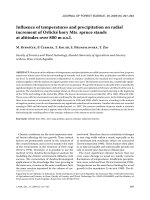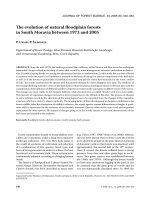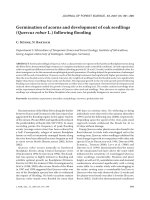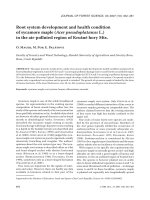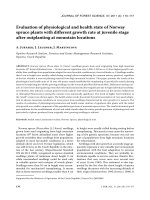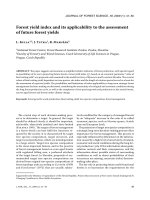Báo cáo lâm nghiệp: "Investigations on vitality and genetic structure in oak stands" pps
Bạn đang xem bản rút gọn của tài liệu. Xem và tải ngay bản đầy đủ của tài liệu tại đây (723.55 KB, 13 trang )
Original
article
Investigations
on
vitality
and
genetic
structure
in
oak
stands
H
Hertel
I Zaspel
Federal
Research
Centre
for
Forestry
and
Forest
Products,
Institute
for
Forest
Tree
Breeding,
Eberswalder
Chaussee
3,
15377
Waldsieversdorf,
Germany
(Received
3
January
1995;
accepted
2
November
1995)
Summary —
Six
oak
stands
with
the
two
indigenous
species
Quercus
petraea
and
Q
robur
were
investigated
in
order
to
establish
relationships
between
the
vitality
of
oak
trees
and
their
genetic
struc-
ture.
The
stands
were
affected
by
the ’European
oak
decline’.
The
registered
traits
of
every
tree
were
branching
habits,
defoliation,
discoloration
of
foliage,
necrosis
on
stems,
epicormic
branches
at
stems
and
in
the
crowns.
The
several
traits
were
integrated
into
a
vitality
coefficient.
Isozyme
analyses
were
carried
out
to
characterize
the
genetic
structure
of
oak
stands
and
subpopulations
distinguished
by
their
vitality.
In
principle,
the
results
indicate
the
same
tendency
for
the
relationship
between
vitality
and
genetic
structure
for
Q
robur and
Q
petraea:
increase
of
excess
of
homozygotes
from
the
tolerant
group
to
the
sensitive
group,
decrease
of
observed
heterozygosity
from
the
tolerant
to
the
sensitive
group,
maximum
hypothetical
gametic
diversity
and
minimum
subpopulation
differentiation
in
the
intermediate
group
as
an
indication
for
a
directed
selection.
Quercus
/ vitality
/ isozyme
marker
/ genetic
structure
/
selection
/
decline
Résumé —
Recherches
sur
la
vitalité
et
la
structure
génétique
de
peuplements
de
chênes.
Six
peuplements
comportant
les
deux
espèces
indigènes
Quercus
petraea
et
Q
robur
ont
été
analysés
dans
le
but
de
relier
la
vitalité
des
arbres
à
leur
structure
génétique.
Les
peuplements
en
question
souffraient
de
dépérissement
marqué.
Les
caractères
notés
sur
chaque
individu
étaient
la
branchaison,
le
degré
de
défoliation,
les
décolorations
du
feuillage,
l’existence
de
nécroses
sur
les
troncs,
et
la
présence
de
rameaux
anticipés
sur
les
troncs
et
dans
les
branches.
Tous
ces
caractères
ont
été
utilisés
pour
la
défi-
nition
d’un
index
de
vitalité.
Des
analyses
d’isozymes
ont
été
entreprises
pour
caractériser
la
structure
génétique
des peuplements,
ou
de
sous-populations
différant
par leur
degré
de
vitalité.
Les
résultats
indiquent
des
tendances
identiques
entre
les
deux
espèces :
augmentation
de
l’excès
d’homozygotes
entre
les
groupes
tolérants
et
ceux
sensibles
au
dépérissement,
baisse
du
degré
d’hétérozygotie
depuis
les
plus
tolérants
aux
plus
sensibles,
diversité
gamétique
maximale
et
faible
degré
de
diffé-
renciation
entre
subpopulations
dans
les
groupes
intermédiaires.
Les
deux
groupes
extrêmes,
à
fort
degré
de
différentiation
intrapopulation,
peuvent
constituer
des
sous-populations
résultant
d’un
processus
de
sélection
lié
au
dépérissement.
Ils
présentent
un
potentiel
réduit
de
production
d’une
nouvelle
génération
avec
une
large
variabilité
génétique,
par
rapport
au
groupe
intermédiaire
à
forte
variabilité
et
à
bonne
capacité
d’adaptation
à
des
modifications
des
conditions
d’environnement.
Quercus
/ vitalité
/
isozymes
/
structure
génétique
/
sélection
/
dépérissement
INTRODUCTION
Oak
trees
are
dominant
forest
tree
species
in
Germany
and
an
important
ecological
and
economical
factor.
Both
species
Quercus
petraea
and
Q
robur
covered
more
than
38%
of
the
total
forest
area
in
the
eastern
part
of
Germany
in
the
past.
This
area
has
been
strongly
decreased
in
the
last
cen-
turies
in
favour
of
conifer
tree
species.
Today,
oaks
are
growing
in
a
tenth
of
their
natural
range
as
major
species
(Kohlstock,
1993).
Therefore,
their
conservation
and
promotion
is
interesting
because
oak
stands
are
more
and
more
endangered
by
the
increasing
process
of
’European
oak
decline’
and
the
shifting
of
climatic
zones.
The
current
process
of
oak
decline
is
not
limited
to
East
Germany
but
is
found
all
over
Europe.
According
to
the
report
of
forest
damage
survey
of
Germany,
distinct
dam-
ages
were
found
on
45%
of
all
oaks
(Anony-
mus,
1993),
thus,
nearly
every
second oak
shows
visible
symptoms.
The
vitality
decrease
appears
to
be
stronger
especially
in
East
Germany.
Here
55%
of
all
oaks
are
clearly
damaged.
This
process
of
decreasing
vitality
is
expressed
in
several
phenotypical
traits
of
the
trees.
The
level
of
damage
varies
from
tree
to
tree
and
includes
the
dying
of
mem-
bers
of
the
stands.
A
regeneration
of
oak
stands
cannot
be
noted
until
now
and
because
of
its
complexity
it
is
not
foresee-
able.
The
capability
of
forest
trees
to
survive
is
based
on
their
adaptation
to
the
existing
environment
and
their
adaptability
to
chang-
ing
environmental
conditions.
Long-living
forest
trees
need
genetic
variability
at
the
level
of
individuals,
among
individuals
in
populations
and
among
populations
in
the
natural
range
of
species
in
order
to
adapt
to
heterogeneous
environmental
conditions.
From
the
view
of
gene
conservation
and
forest
tree
breeding,
it
is
important
to
gain
information
about
the
genetic
structure
effect
on
the
sensitivity
to
’European
oak
decline’
and
the
influences
of
decline
on
genetic
structure
of
stands
in
the
next
generation.
Preconditions
for
that
are
investigations
con-
cerning
the
state
of
damage
of
oak
trees
and
the
complete
evaluation
of
their
vitality
in
the
stands
based
on
phenotypic-mor-
phological
traits
and
the
description
of
the
genetic
structure
in
the
research
area.
MATERIALS
AND
METHODS
Trials
Six
experimental
sites
were
established
as
per-
manent
observation
plots.
They
are
situated
on
Pleistocene
Forest
soils
formed
by
the
last
two
stages
of
the
Weichselian
Glaciation
Period.
The
sites
are
located
in
the
eastern
part
of
Germany,
in
the
area
of
Brandenburg
(fig
1).
The
mean
annual
temperature
ranges
from
8.2
to
8.4
°C,
the
average
annual
rainfall
amounts
to
520
and
570
mm.
The
vegetation
types
of
the
sites
are
pine(linden)-sessile
oak
forests
or
beech-
pedunculate
oak
forests.
The
site
type
of
all
six
experimental
stands
is
characterized
by
sufficient
supply
with
nutrients
and
average
but
varying
water
supply
(K2).
All
stands
are
established
artificially.
The
planted
material
of
five
stands
came
from
surrounding
forests,
the
origin
of
the
trees
of
the
stand
’Blu-
menthal’
1
is
unknown.
Three
of
the
six
stands
are
mixed
stands
with
Q petraea
and
Q
robur.
Every
tree
was
assigned
to
the
species
belonging
to
leaf
traits
(leaf
shape,
nervature)
and
acorn
traits
according
to
Aas
(1988).
There
was
no
individual
with
indifferent
traits
in
our
study
which
possibly
could
be
a
hybrid.
An
overview
on
the
six
trials
is
given
in
table
I.
Assessment
of
damage
The
estimation
of
vitality
includes
several
traits
which
are
described
by
their
classification
in
table
II.
The
stands
were
evaluated
for
the
traits
branch-
ing
structure,
water
sprouts
of
stem,
water
sprouts
of
crown,
and
bark
necrosis
in
the time
between
December
and
March.
The
traits
discoloration
of
leaves
and
defoliation
were
examined
in
late
spring
or
early
summer.
The
trait
defoliation
con-
tains
the
assessment
of
feeding
activity
of
insect
pathogens
and
abscission
of
twigs
after
dry
peri-
ods
especially.
The
branching
structure
of
the
crowns
were
classified
after
the
estimation
key
of
Roloff
(1989).
The
scores
of
the
other
visible
symptoms
were
fixed
with
regard
to
the
situation
of
oak
decline
of
all
six
stands
and
the
possibility
of
their
actual
estimation.
The
traits
were
weighed
differently
and
added
up
into
a
vitality
coefficient.
All
trees
were
arranged
into
the
vitality
groups
’tolerant’,
’inter-
mediate’,
and
’sensitive’.
The
limits
between
the
vitality
groups
were
determined
according
to
the
accumulation
of
the
individual
values
of
the
tree’s
vitality.
The
values
of
the
vitality
coefficient
of
the
tolerant
group
ranged
from
1.1
to
2.0;
the
values
of
the
vitality
coefficient of
the
intermediate
group
ranged
from
2.1
to
2.6;
the
values
of
the
sensitive
group
enclosed
values
of
more
than
2.6.
Dead
trees
were
recorded
in
favour
of
a
description
of
the
structures
of
the
stands
and
the
oak
decline
course
inside
the
stands.
Description
of
the
genetic
structure
Isozyme
analyses
were
carried
out
for
ten
enzyme
systems
encoded
by
11
loci
listed
in
table
III.
Dor-
mant
buds
of
the
trees
were
homogenized
in
extraction
buffer
(modified
from
Lundkvist,
1974)
containing
1%
(v/v)
2-mercaptoethanol
and
5%
(w/v)
Polyclar
AT.
The
proteins
were
separated
by
horizontal
starch
gel
electrophoresis
with
the
fol-
lowing
buffer
systems:
(A)
12.5%
starch
in
0.02
M
Tris
citrate
buffer
pH
7.5,
electrode
buffer:
0.15
M
Tris
citrate
buffer
pH
7.5;
(B)
12.5%
starch
in
0.05
M
Tris
citrate
buffer
pH
8.1,
electrode
buffer:
0.2
M
lithium
borate
buffer
pH
8.1;
(C)
12.5%
starch
in
0.075
M
Tris
citrate
buffer
pH
8.7,
electrode
buffer:
0.3
M
sodium
borate
buffer
pH
8.3.
For
the
enzyme
systems
AAT
and
GDH,
the
proteins
were
separated
by
electrophoresis
in
polyacry-
lamide
slab
gels
(PAGE,
7.5%
polyacrylamide
in
0.375
M
Tris-HCI
buffer
pH
8.9,
and
0.19
M
Tris
glycine
electrode
buffer
pH
8.3;
Maurer,
1968).
Specific
staining
solutions
for
the
enzymes
6PGDH,
GDH,
AAT
and
PGI
were
modified
from
Yeh
and
O’Malley
(1980),
and
stains
for
the
enzymes
ACP,
IDH,
PGM
and
AP
followed
Valle-
jos
(1983).
The
staining
solutions
for
MR
and
NDH
were
modified
from
Cheliak
and
Pitel
(1984).
The
observed
heterozygosity
Ho
at
a
locus
is
equal
to
the
proportion
of
heterozygous
trees
among
all
tested
trees.
The
expected
heterozy-
gosity
He
is
the
proportion
of
heterozygotes
at
the
Hardy-Weinberg
equilibrium.
The
total
popu-
lation
differentiation
δ
T
was
used
to
even
out
the
different
sample
sizes
(Gregorius,
1987).
The
fix-
ation
index
F was
calculated
as
F =
1 -
Ho
/
He.
The
gene
pool
diversity
was
calculated
as
the
harmonic
mean
of
the
allelic
diversities
v1
=
1 / Σ
p21
(Gregorius,
1987).
The
genetic
distances
and
the
hypothetical
gametic
diversity
(V =
Π
vl)
were
calculated
according
to
Gregorius
(1978).
The
calculation
of
the
subpopulation
differentiation
Dj
and
the
differentiation
δ
of
subdivided
gene
pools
followed
Gregorius
and
Roberds
(1986).
Statistics
The
comparison
of
samples
based
on
ordinal
scale
was
realized
by
the
test
of
Kruskal-Wallis.
The
test
of
homogeneity
of
the
population’s
sam-
pling
distribution
was
realized
by
the Fisher
test
or
by
the
Maximum-Likelihood
test
when
the
sample
size
was
sufficient.
The
cluster
analysis
(aver-
age
linkage
method)
was
carried
out
with
pair-
wise
genetic
distances
based
on
allele
frequen-
cies.
All
data
were
computed
by
the
Statistical
Analysis
System
(SAS
Institute,
Inc,
USA).
RESULTS
Comparison
between
oak
species
The
six
experimental
sites
possess
differ-
ent
numbers
of
trees
in
pure
stands
of
Q
petraea
and
Q
robur,
respectively,
or
mixed
stands
with
both
species
(for
sam-
ple
sizes,
see
table
I).
Their
distribution
is
irregular
and
is
a
consequence
of
the
use
of
mixed
acorns
in
the
time
of
stand
estab-
lishment.
The
vitality
coefficients
of
both
oak
species
differ
significantly
at
the
level
of
P
=
0.001.
They
amount
to
2.15
for
the
species
Q
petraea
and
to
2.41
for
Q
robur.
The
com-
parison
of
the
vitality
coefficients
of
both
species
growing
on
the
three
mixed
stands
also
shows
a
significant
difference
at
the
same
significance
level.
In
this
case,
they
amount
to
2.27
for
Q
petraea
and
to
2.44
for
Q
robur.
Q
petraea
shows
a
better
branching
structure
in
the
crown
than
Q
robur.
Pedun-
culate
oak
trees
tend
more
to
discoloration
of
leaves
and
to
the
formation
of
epicormic
branches
of
the
crown.
Furthermore,
the
trait
’defoliation’
is
expressed
more
inten-
sively
in
Q
robur,
as
this
species
shows
lower
disposition
to
form
epicormic
branches
of
stems.
The
total
number
of
necroses
of
stems
is
higher
in
the
species
Q
robur,
but
Q petraea
shows
larger
necroses.
Thus,
Q
petraea
has
a
stronger
reaction
in
the
case
of
development
of
necrotic
bark
tissue
(fig
2).
The
genetic
structure
of
262
individuals
of
Q
robur
trees
and
118
individuals
of
Q
petraea
trees
was
described
by
isozyme
gene
markers.
A
total
number
of
44
alle-
les
at
all
11
loci
tested
was
detected,
41
alleles
in
case
of
pedunculate
oak and
37
in
case
of
sessile
oak.
The
allelic
frequencies
of
all
loci
are
presented
in
table
IV.
The
enzyme
gene
loci
PGM-A,
ACP-C,
GDH,
IDH-B
and
AP-B
exhibit
the
most
substantial
differences
in
the
allelic
frequencies
between
the
indigenous
oak
species
in
the
region
of
eastern
Germany.
Their
genetic
distances
range
from
0.446
to
0.192,
but
it
is
impos-
sible
to
identify
the
species
of
an
individual
by
its
isozyme
genotype
because
there
are
no
alleles
specific
for
species.
The
dendrogram
demonstrates
clearly
that
the
genetic
distances
between
the
regarding
the
species
separately,
are
small
in
comparison
with
the
distance
between
the
two
species
(fig
3).
Comparison
between
sites
The
comparison
of
the
vitality
coefficients
of
the
three
experimental
sites
with
mixed
stands
show
lower
values
in
sessile
oaks.
Thus,
Q
petraea
possesses
a
better
vital-
ity
compared
with
Q
robur at
the
stands
(table
V).
Generally,
the
variability
of
vitality
coef-
ficients
among
single
trees
in
the
stands
was
greater
than
the
differences
between
the
stands.
The
single
morphological
traits
tend
to
differ
more
between
the
stands
and
show
partly
significant
differences.
In
some
cases,
significance
appears
between
very
small
differences
and,
in
contrast,
greater
differences
are
not
significant.
This
depends
on
the
sample
size
of
the
single
stands
and
the
standard
deviation.
In
order
to
compare
the
genetic
struc-
ture
of
the
experimental
sites,
genetic
parameters
were
surveyed
separately
for
Q
robur and
Q
petraea
(table
VI).
The
stand
"Rosinsee"
is
remarkable
for
its
maximum
gene
pool
and
hypothetical
gametic
diversity
for
Q
robur as
well
as
Q
petraea.
Although
there
is
a
rank
correla-
tion
between
the
average
observed
het-
erozygosity
and
the
stand’s
average
value
of
the ’branching
structure’ as
well
as
the
aver-
age
vitality’s
coefficient
for
Q
robur,
we
can
state
that
the
most
variation
is
among
the
individuals
in
a
stand
and
not
among
the
stands.
Therefore,
an
attempt
was
made
to
pool
all
trees
of
each
species
for
the
fol-
lowing
comparison
of
vitality
classes.
Comparison
between
the
vitality
classes
The
division
of
all
investigated
trees
into
three
vitality
groups
based
on
their
calcu-
lated
vitality
coefficients
allowed
the
coher-
ent
consideration
of
results
of
damage
assessment
and
of
the
genetic
parameters
for
both
oak
species.
The
evaluation
of
the
relationship
between
single
phenotypical
traits
and
genetic
structure
requires
further
investiga-
tion
and
will
be
presented
in
a
separate
study.
The
relationship
between
the
vitality
groups
and
the
genetic
parameters
without
regard
to
single
phenotypical
traits
will
be
considered
here.
One
of
the
most
obvious
differences
between
the
vitality
classes
is
the
increase
of
an
excess
of
homozygotes
(fixation
index
Fin
table
VII)
from
the
group
of
tolerant
to
the
group
of
sensitive
trees
(significant
at
the
0.05
level
for
Q
robur),
whereas
the
het-
erozygosity
Ho
tends
to
show
a
decrease
(table
VII).
These
two
parameters
have
been
influenced
by
the
genotypical
struc-
ture.
The
parameters
which
are
derived
from
the
allelic
frequencies
only
(expected
het-
erozygosity,
gene
pool
and
hypothetical
gametic
diversities)
exhibit
the
maximum
values
in
the
intermediate
vitality
class
for
Q
robur and
Q petraea
(table
VII).
The
high
levels
of
hypothetical
gametic
diversities
of
the
intermediate
class
demonstrate
the
potential
of
these
groups
to
produce
gametes
with
a
high
genetic
variation.
In
addition,
these
intermediate
vitality
groups
of
both
oak
species
show
the
lowest
level
of
subpopulation
differentiation
for
a
majority
of
scored
gene
loci
and
for
the
average
value
(table
VIII).
DISCUSSION
In
this
study,
the
attempt
was
made
to
find
relationships
between
the
vitality
of
oak
trees
described
by
several
morphological
traits
and
their
genetic
structure.
The
process
of
oak
decline
is
marked
by
the
temporal
and
spatial
interrelation
of
biotic
and
abiotic
fac-
tors
causing
a
decrease
of
vitality
of
the
trees.
It
is
known
that
the
development
of
the
recent
forest
damages
are
also
weather-
induced.
The
variation
in
temperature
and
the
amount
of
rainfall
of
former
years
plays
a
particularly
important
role.
The
annual
averages
of
temperature
of
the
research
area
were
higher
in
the
period
from
1980
to
1990
than
the
long-term
aver-
age,
especially
in
winter
months.
In
addi-
tion,
the
annual
amount
of
rainfall
decreased
in
this
time,
especially
in
the
summer
and
autumn
periods
(Smukalski
et al,
1992).
The
traits
which
had
been
found
and
regarded
as
a
vitality
decrease
of
oaks
cor-
responded
with
the
incidence
of
damages
described
by
Balder
and
Lakenberg
(1987)
and
Oosterbaan
(1987).
The
branching
structure
documents
well
the
abiotic
and
biotic
long-term
effects.
Therefore,
the
branching
structure
was
weighed
as
the
most
essential
trait.
The
other
traits
(ie,
defoliation,
discoloration,
bark
necroses
and
epicormic
branches
of
crown
and
stem)
partly
represent
long-term
as
well
as
short-term
effects.
They
were
weighed
lower.
Strong
impacts
of
leave-feeding
insects
occurred
in
most
of
the
tested
stands
from
1991
to
1993.
Mainly
Tortrix
viridiana
and
Operophthera
brumata
were
observed.
Both
oak
species
were
equally
effected
by
them.
In
the
year
1992,
Haltica
quercetorum
occurred
in
the
sessile
oak
stands
"Tiefensee"
and
"Rehhagen"
additionally
and
severly
damaged
the
lower
parts
of
crowns
and
epicormic
branches.
The
influence
of
repeated
loss
of
leaves
during
the
vegetation
period
by
feeding
insects,
along
with
drought
and
high
tem-
perature,
plays
an
important
role
in
the
pro-
cess
of
decreasing
vitality
(Krapfenbauer,
1988).
It
is
also
possible
that
other
pheno-
typical
characters,
such
as
flowering
and
fruit
production,
have
an
influence
on
the
production
of
leaves
during
the
vegetation
period
(Roloff,
1989).
These
examples
may
show
that
the
loss
of
leaves
per
se
is
not
a
sign
for
the
decline
process
in
every
case.
Löchelt
and
Franke
(1993)
did
not
observe
any
relation
between
the
loss
of
leaves
of
investigated
oak
trees
and
one
of
the
calcu-
lated
genetic
measures.
Our
data
on
the
genetic
characterization
of
oak
species
and
oak
stands
are
in
good
agreement
with
the
published
data
of
Müller-Starck
and
Ziehe
(1991)
and Kremer
and
Petit
(1993).
The
relative
broad
basis
of
the
vitality
classification
of
trees
into
tolerant,
interme-
diate
and
sensitive
groups
might
facilitate
us
to
find
out
whether
there
is
an
influence
of
the
genetic
structure
on
the
sensitivity
to
the
European
oak
decline.
This
is
the
first
report
about
a
detectable
relationship
between
the
genetic
structure
and
phenotypical
traits
which
characterizes
the
vitality
for
the
tree
species
Q
robur and
Q
petraea.
The
results
are
principally
the
same
for
both
species.
We
have
found
similar
differences
for
the
observed
heterozygosity
between
the
tol-
erant
and
sensitive
vitality
classes
as
have
Bergmann
and
Scholz
(1987)
and
Raddi
et
al
(1994)
for
Picea
abies,
Geburek
et
al
(1987)
for
Pinus
sylvestris
and
Müller-Starck
(1985, 1989)
and
Hertel
and
Zander
(1991)
for
Fagus
sylvatica.
Most
of
the
authors
cited
here
used
the
pairwise
sampling
method
(Gregorius,
1989)
to
compare
the
genetic
structure
of
the
population’s
subsets.
Our
inclusion
of
all
trees
in
small
exper-
imental
plots
in
the
investigation
meant
nearly
the
same
random
association
between
genotype
and
environment
as
the
method
of
pairwise
sampling
(similar
to
Kon-
nert,
1993).
Additionally,
we
had
the
possi-
bility
to
consider
an
intermediate
group.
The
different
sample
sizes
of
the
tolerant,
inter-
mediate
and
sensitive
vitality
classes
for
both
species
represent
the
conditions
in
the
locations
we
studied.
The
fixation
index
measures
the
devia-
tion of
the
proportion
of
the
observed
het-
erozygotes
to
the
proportion
of
heterozygotes
at
the
Hardy-Weinberg
equilibrium.
Values
below
zero
indicate
an excess
of
heterozy-
gotes
and
above
zero
an
excess
of
homozy-
gotes.
A
decreasing
fixation
index
was
used
to
describe
the
natural
selection
against
inbreeds
during
the
ontogenesis,
which
was
found,
for
example,
for
pine
species
during
the
seedling
development
(Muona
et
al,
1987;
Morgante
et
al,
1993)
and
for
age
classes
from
10
to
40
years
(Starova
et
al,
1990).
In
the
present
study,
tree
groups
of
the
same
age
class
show
a
decreasing
fixation
index,
ie,
decreasing
excess
of
homozygotes
with
increasing
vitality.
A
directed
selection
is
also
derived
from
the
level
of
subpopulation
dif-
ferentiation
of
the
vitality
classes.
The
sub-
population
differentiation
is
used
to
describe
the
genetic
distance
of
one
group
to
the
remainder
of
the
population.
Groups
with
low
values
of
subpopulation
differentiation
bet-
ter
represent
the
gene
pool
of
the
whole
pop-
ulation
than
groups
with
high
levels
of
sub-
population
differentiation.
The
two
groups,
ie,
tolerant
and
sensi-
tive
trees
with
higher
values
of
subpopula-
tion
differentiation
than
the
intermediate
group,
could
be
understood
as
special
sub-
populations
after
a
differentiation
process
by
the
European
oak
decline.
They
have
a
reduced
potency
to
form
the
next
genera-
tion
with
a
high
genetic
variation
in
com-
parison
with
the
intermediate
group
with
a
maximum
hypothetical
gametic
diversity
and
thereby
a
favourable
general
ability
for
adap-
tation
at
changing
environmental
conditions.
Until
now,
we
did
not
have
knowledge
about
the
reproductive
success
of
oak
trees
of
different
vitality.
The
variability
in
acorn
production
was
reviewed
by
Ducusso
et
al
(1993)
without
indication
of
the
influence
of
the
tree’s
vitality.
Nevertheless,
we
could
assume
that
the
offspring
quantities
of
dam-
aged
trees
decrease
over
a
long
period,
since,
for
instance,
Köhler
and
Stratmann
(1986)
and
Cufar
et
al
(1994)
observed
this
appearance
for
conifer
species.
Under
this
condition,
the
genetic
structure
of
the
next
generations
would
approach
the
structure
of
the
tolerant
group,
thus
meaning
an
adap-
tation
process
at
the
level
of
populations,
if
the
selection
pressure
is
the
same
as
in
the
previous
generation.
ACKNOWLEDGMENTS
We
acknowledge
Prof
Dr
N
Kohlstock
and
Dr
DR
Eisenhauer
for
their
suggestions
to
this
work
and
the
selection
of
oak
sites
and
Mr
C
Mertens
for
his
contribution
to
the
survey
on
the
stands
Rosin-
see
and
Plagefenn.
Furthermore,
we
thank
Mrs
E
Ewald
and
Mrs
M
Schneck
for
their
assistance
in
the
isozyme
analysis.
REFERENCES
Aas
G
(1988)
Untersuchungen
zur
Trennung
und
Kreuzbarkeit
von
Stiel-
und
Traubeneiche.
Disser-
tation,
München,
Germany,
158
p
Anonymus
(1993)
Waldzustandsbericht
der
Bun-
desregierung.
Ergebnisse
der
Waldschadenserhe-
bung
1993.
Bonn,
Germany
Balder
H,
Lakenberg
E
(1987)
Neuartiges
Eichensterben
in
Berlin.
Allg
Forst Zeitsch
27/28/29,
684-685
Bergmann
F,
Scholz
F
(1987)
The
impact
of
air
pollution
on
the
genetic
structure
of
Norway
spruce.
Silvae
Genet
36,
80-83
Cheliak
WM,
Pitel
JA
(1984)
Techniques
for
starch
gel
electrophoresis
of
enzymes
from
forest
tree
species.
Information
Report
PI-X-42,
Petawawa
National
Forestry
Institute
Cufar
K,
Robic
D,
Torelli
N,
Kermavnar
A
(1994)
Blüten-
bildung
unterschiedlich
geschädigter
Weißtannen
in
Slowenien.
Forst Holz 49,
34-36
Ducusso
A,
Michaud
H,
Lumaret
R
(1993)
Reproduc-
tion
and
gene
flow
in
the
genus
Quercus.
Ann
Sci
For
50 (Suppl 1),
91s-106s
Geburek
T,
Scholz
F,
Knabe
W,
Vornweg
A
(1987)
Genetic
studies
by
isozyme
gene
loci
on
tolerance
and
sensitivity
in
air
polluted
Pinus
sylvestris
field
trial.
Silvae
Genet 36,
49-53
Gregorius
HR
(1978)
The
concept
of
the
genetic
diver-
sity
and
its
formal
relationship
to
heterozygosity
and
genetic
distance.
Math
Biosci 41, 253-271
Gregorius
HR
(1987)
The
relationship
between
the
con-
cepts
of
genetic
diversity
and
differentiation.
Theor
Appl
Genet
74, 397-401
Gregorius
HR
(1989)
The
attribution
of
phenotypic
vari-
ation
to
genetic
or
environmental
variation
in
eco-
logical
studies.
In:
Genetic
Effects
of Air Pollution
in
Forest
Tree
Populations
(F
Scholz,
HR
Gregorius,
D
Rudin,
eds),
Springer-Verlag,
Berlin,
3-15
Gregorius
HR,
Roberds
JH
(1986)
Measurement
of
genetical
differentiation
among
subpopulations.
Theor
Appl Genet 71,
826-834
Hertel
H,
Zander
M
(1991)
Genetische
Unterschiede
zwischen
gesunden
und
geschädigten
Buchen
eines
belasteten
Bestandes.
In:
Berichte
des
Forschungszentrums
Waldökosysteme
der
Univer-
sität
Göttingen,
Reihe
B,
Bd
22,
227-229
Köhler
H,
Stratmann
J
(1986)
Wachstum
und
Benadelung
von
Fichten
im
Westharz.
Forst
Holzwirt,
Heft 6,
152-157
Kohlstock
N
(1993)
Standortgerechter
Waldbau
in
Bran-
denburg
in
Tradition
und
Zukunft.
Der
Wald
Berlin
43,
364-368
Konnert
M
(1993)
Untersuchungen
zum
Einfluß
genetis-
cher
Faktoren
auf
die
Schädigung
der
Weißtanne.
Forstwiss
Cbl 112,
20-26
Krapfenbauer
A
(1988)
Kronenverlichtung
über
die
Bil-
dung
von
Trenngeweben
und
Zweigabwürfen
in
Verbindung
mit
den
Eichenerkrankungen.
Österreich
Forstzeitung
1, 52-53
Kremer
A,
Petit
RJ
(1993)
Gene
diversity
in
natural
pop-
ulations
of
oak
species.
Ann
Sci
For 50
(Suppl
1),
186s-202s
Löchelt
S,
Franke
A
(1993)
Bestimmung
der
genetis-
chen
Konstitution
von
Waldbäumen
mit
unter-
schiedlichen
Schadsymptomen
auf
baden-württem-
bergischen
Dauerbeobachtungsflächen
zur
Walderkrankung.
Projekt
Europäisehes
Forschungszentrum
für
Maßnahmen
der
Luftrein-
haltung,
Forschungsbericht
KfK
PEF
108,
Kern-
forschungs-zentrum
Karlsruhe
Lundkvist
K
(1974)
Inheritance
of
leucine
aminopeptidase
isoenzymes
in
Picea
abies
K.
Hereditas 76,
91-96
Maurer
R
(1968)
Disk-Elektrophorese.
Walter
de
Gruyter
&
Co,
Berlin
Morgante
M,
Vendramin
GG,
Rossi
P,
Olivieri
MA
(1993)
Selection
against
inbreeds
in
early
life-cycle
phases
in
Pinus
leucodermis
Ant.
Heredity 70,
622-627
Müller-Starck
G
(1985)
Genetic
differences
between
"tolerant"
and
"sensitive"
beeches
in
an
environ-
mental
stressed
adult
forest
stand.
Silva
Genet 34,
241-247
Müller-Starck
G
(1989)
Genetic
imlications
of
environ-
mental
stress
in
adult
forest
stands
of
Fagus
sylvat-
ica
L.
In:
Genetic
Effects
of Air
Pollutants
in
Forest
Tree
Populations
(F
Scholz,
HR
Gregorius,
D
Rudin,
eds),
Springer-Verlag,
Berlin,
127-142
Müller-Starck
G,
Ziehe
M
(1991)
Genetic
variation
in
populations
of
Fagus
sylvatica
L,
Quercus
robur
L,
and
Q petraea
Liebl
in
Germany.
In:
Genetic
Varia-
tion
in
European
Populations
of
Forest
Trees
(G
Müller-Starck,
M
Ziehe,
eds),
Sauerländer’s
Verlag,
Frankfurt,
125-140
Muona
O,
Yazdani
R,
Rudin
D
(1987)
Genetic
change
between
life
stages
in
Pinus
sylvestris:
allozyme
variation
in
seeds
and
plated
seedlings.
Silva
Fenn
36, 39-42
Oosterbaan
A
(1987)
Eichensterben
auch
in
den
Nieder-
landen.
Allg
Forst Zeitsch
37, 926
Raddi
S,
Stefanini
FM,
Camussi
A,
Giannini
R
(1994)
Forest
decline
index
and
genetic
variability
in
Picea
abies
(L)
Karst.
For
Genet
1,
33-40
Roloff
(1989)
Kronenentwicklung
und
Vitalitätsbeurteilung
ausgewählter
Baumarten
der
gemäßigten
Breiten.
Schriften
aus
der
Forstl
Fakultät
der
Universität
Göt-
tingen
und
der
Niedersächs
Forstl
Versuchsanst,
Bd
93, 258
p
Smukalski
M,
Rogasik
J,
Künkel
KJ
(1992)
Landbau
und
Treibhauseffekt -
CO
2
-Umsatz
bei
unter-
schiedlicher
Intensität
der
Landbewirtschaftung.
LandbauforschgVölkenrode
42,
55-61
Starova
NV,
Yanbayev
YA,
Yumadilov
KN,
Adler
NE,
Dukharev
AV,
Shigapov
ZK
(1990)
Genetic
vari-
ability
of
Pinus
sylvestris
in
age
classes.
Genetika
26,
498-505
[in
Russian]
Vallejos
CE
(1983).
Enzyme
activity
staining.
In:
Isoen-
zymes
in
Plant
Genetics
and
Breeding
(SD
Tanksley,
TJ
Orton,
eds),
Elsevier
Science,
Amsterdam,
481-
515
Yeh
FC,
O’Malley
D
(1980)
Enzyme
variations
in
natu-
ral
populations
of
Douglas-fir,
Pseudotsuga
men-
ziesii (Mirb)
Franco,
from
British
Columbia.
I. Genetic
variation
patterns
in
coastal
populations.
Silvae
Genet
29, 83-92


